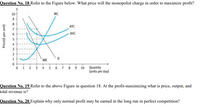
ENGR.ECONOMIC ANALYSIS
14th Edition
ISBN: 9780190931919
Author: NEWNAN
Publisher: Oxford University Press
expand_more
expand_more
format_list_bulleted
Question

Transcribed Image Text:Question No. 18 Refer to the Figure below. What price will the monopolist charge in order to maximize profit?
10
MC
ATC
6.
- AVC
3.
MR
0 1 2 3 4 5 6 7 8 9 10 Quantity
(units per day)
Question No. 19 Refer to the above Figure in question 18. At the profit-maximizing what is price, output, and
total revenue is?
Question No. 20 Explain why only normal profit may be earned in the long run in perfect competition?
Price(£ per unit)
Expert Solution
This question has been solved!
Explore an expertly crafted, step-by-step solution for a thorough understanding of key concepts.
This is a popular solution
Trending nowThis is a popular solution!
Step by stepSolved in 4 steps

Knowledge Booster
Learn more about
Need a deep-dive on the concept behind this application? Look no further. Learn more about this topic, economics and related others by exploring similar questions and additional content below.Similar questions
- $13 12 MC 10 ATC Demand 4. 3. MR 1 3. 4. 6. Quantity (units per hour) ***Refer to Fig 7.3. Outline the monopolist profit rectangle. On the graph, label the price the monopolist will charge, the quantity the monopolist will produce, the TR and TC. Calculate the profit in the space above. produce a quanity of Fill in the blanks. A profit-maximizing monopolist will charge a price of Must show work above. units per hour, and earn a profit of Price or cost (per unit) 1.arrow_forwardPlease help with the question attachedarrow_forwardIf the monopolist depicted in the graph above sets the price to maximize profit, it will earn economic profit of: Group of answer choices a. $2,400 per day. b. $4,800 per day. c. $7,200 per day. d. $1,600 per day.arrow_forward
- 1) what point is Market outcome? 2) what area is profit or loss? 3)how do I find total cost for different prices? 4)would charging 2.25 per can be ideal?arrow_forward27 30 Page 4: 31 ✓ 34 37 40 41 28 44 Page 5: 32 33 35 36 29 38 39 42 M 45 43 46 The figure below shows the demand schedule and demand curve for a product produced by a single-price monopolist. Price ($) 10 2967 6 5 43 2 - 8 0 1 2 3 4 5 6 7 8 9 10 11 12 Quantity + Suppose this single-price monopolist is initially selling 5 units at $8 each and then reduces the price of the product to $7. By making this change, the revenue the firm gains from the additional units it can now sell isarrow_forwardtion 14 of 23 Identity what type of price discrimination, if any, is described in each scenario. a. Art's Mac-n-Cheese sells for $0.99 at the Piggly Wiggly, but Bulky Warehouse sells a package of 12 boxes for $10. Perfect price discrimination ) Third-degree price discrimination Second-degree price discrimination No price discrimination b. Pandy Jewelry charges each customer the maximum he or she is willing to pay for a particular piece of jewelry. Perfect price discrimination Third-order price discrimination O Second-order price discrimination No price discrimination.arrow_forward
- help please answer in text form with proper workings and explanation for each and every part and steps with concept and introduction no AI no copy paste remember answer must be in proper format with all workingarrow_forwardSuppose an airline sells air tickets to two types of customer – business travelersand vacation travelers. Their estimated demand elasticities are -2.5 and -4.0respectively.Suppose the marginal cost is constant at $240, and the services provided to thetwo types of customer are similar. Calculate the fares the airline should charge on the air tickets sold to therespective types of customers. Show your calculations.arrow_forwardHello, I need some clarity on this queston. If you can explain briefly how you got your answers that will be very helpful.arrow_forward
- If the monopolist shown in the following figure could implement a two- part tariff, the entry fee would be: $0. $225. $450. $900. $1,200.arrow_forwardWhich price and quantity combination is undesirable for both the monopolist firm and society? A and E B and F C and G D and H A and Harrow_forwardexplain why a monopoly would want to price discriminate explain the (potential) effects of price discrimination on market efficiency.arrow_forward
arrow_back_ios
SEE MORE QUESTIONS
arrow_forward_ios
Recommended textbooks for you

 Principles of Economics (12th Edition)EconomicsISBN:9780134078779Author:Karl E. Case, Ray C. Fair, Sharon E. OsterPublisher:PEARSON
Principles of Economics (12th Edition)EconomicsISBN:9780134078779Author:Karl E. Case, Ray C. Fair, Sharon E. OsterPublisher:PEARSON Engineering Economy (17th Edition)EconomicsISBN:9780134870069Author:William G. Sullivan, Elin M. Wicks, C. Patrick KoellingPublisher:PEARSON
Engineering Economy (17th Edition)EconomicsISBN:9780134870069Author:William G. Sullivan, Elin M. Wicks, C. Patrick KoellingPublisher:PEARSON Principles of Economics (MindTap Course List)EconomicsISBN:9781305585126Author:N. Gregory MankiwPublisher:Cengage Learning
Principles of Economics (MindTap Course List)EconomicsISBN:9781305585126Author:N. Gregory MankiwPublisher:Cengage Learning Managerial Economics: A Problem Solving ApproachEconomicsISBN:9781337106665Author:Luke M. Froeb, Brian T. McCann, Michael R. Ward, Mike ShorPublisher:Cengage Learning
Managerial Economics: A Problem Solving ApproachEconomicsISBN:9781337106665Author:Luke M. Froeb, Brian T. McCann, Michael R. Ward, Mike ShorPublisher:Cengage Learning Managerial Economics & Business Strategy (Mcgraw-...EconomicsISBN:9781259290619Author:Michael Baye, Jeff PrincePublisher:McGraw-Hill Education
Managerial Economics & Business Strategy (Mcgraw-...EconomicsISBN:9781259290619Author:Michael Baye, Jeff PrincePublisher:McGraw-Hill Education


Principles of Economics (12th Edition)
Economics
ISBN:9780134078779
Author:Karl E. Case, Ray C. Fair, Sharon E. Oster
Publisher:PEARSON

Engineering Economy (17th Edition)
Economics
ISBN:9780134870069
Author:William G. Sullivan, Elin M. Wicks, C. Patrick Koelling
Publisher:PEARSON

Principles of Economics (MindTap Course List)
Economics
ISBN:9781305585126
Author:N. Gregory Mankiw
Publisher:Cengage Learning

Managerial Economics: A Problem Solving Approach
Economics
ISBN:9781337106665
Author:Luke M. Froeb, Brian T. McCann, Michael R. Ward, Mike Shor
Publisher:Cengage Learning

Managerial Economics & Business Strategy (Mcgraw-...
Economics
ISBN:9781259290619
Author:Michael Baye, Jeff Prince
Publisher:McGraw-Hill Education